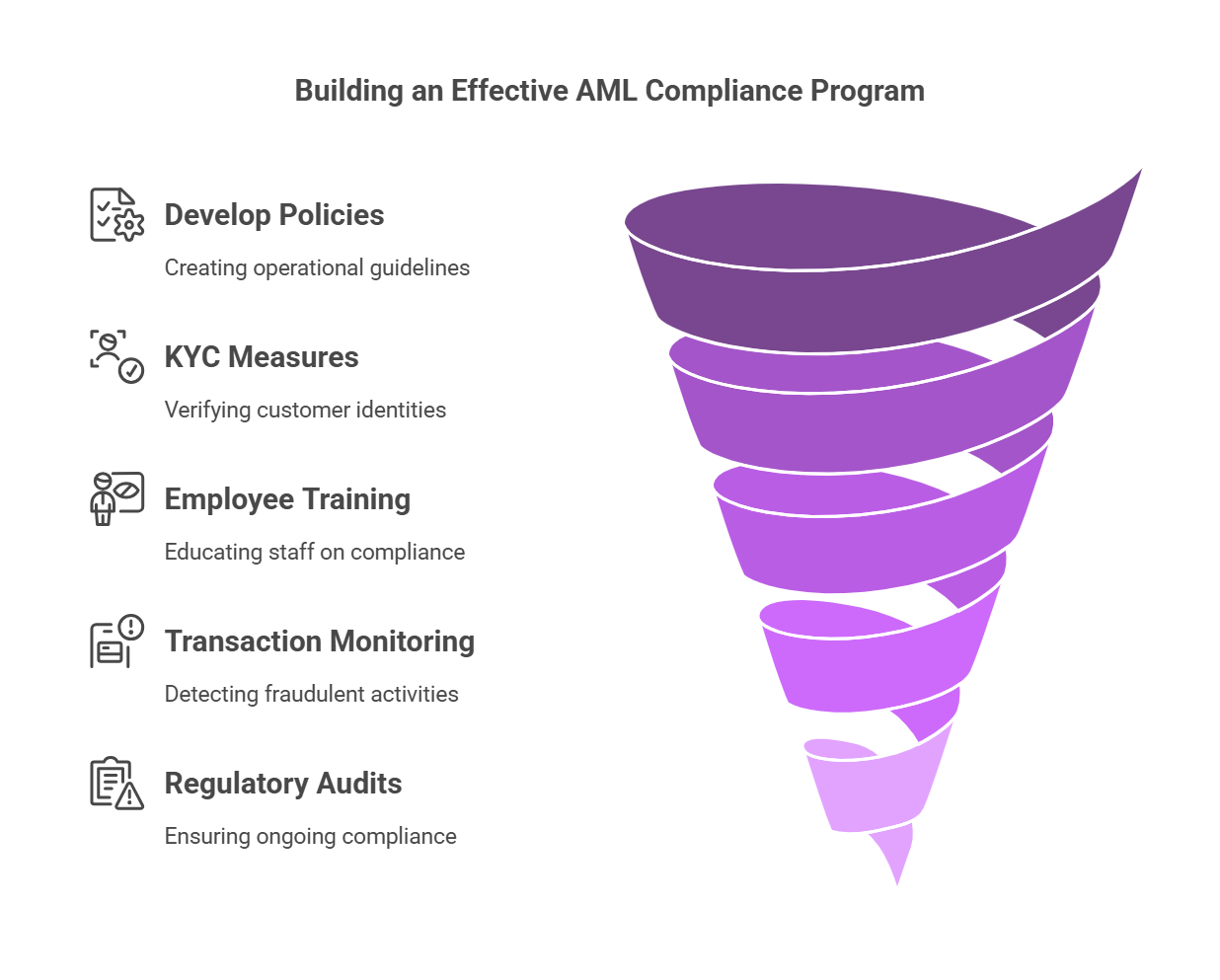Learn the 6 essential steps to building a strong AML compliance program, ensuring regulatory compliance and financial crime prevention.

AML compliance is an essential component of modern financial operations, helping businesses prevent money laundering, fraud, and financial crimes. A well-structured AML compliance program ensures adherence to regulatory requirements while safeguarding an organisation’s reputation.
In this article, we’ll explore 6 critical steps to building a robust AML compliance framework, covering key aspects such as risk and compliance, KYC compliance, and an AML compliance checklist.

1. Conduct a Comprehensive Risk Assessment
An effective AML compliance program begins with a thorough risk assessment to identify vulnerabilities in an organisation’s financial activities.
Key Areas to Assess in Compliance AML:
- Customer Risk – Are you dealing with high-risk customers, such as politically exposed persons (PEPs)?
- Transaction Risk – Do transactions involve large sums, frequent transfers, or high-risk jurisdictions?
- Product/Service Risk – Are your products or services susceptible to misuse (e.g., cryptocurrency, remittances, or digital wallets)?
Actionable Steps:
- Utilise a risk matrix to assess exposure.
- Regularly update your risk assessment based on evolving threats.
- Assign a junior compliance officer or compliance analyst to oversee monitoring.
By understanding risks, businesses can implement effective compliance controls to mitigate financial crimes.
2. Develop AML Policies and Procedures
A well-documented AML compliance checklist ensures clear operational guidelines. Organisations must develop policies that align with global standards, such as those set by the Financial Action Task Force (FATF) and local regulatory bodies.
Essential AML Policies:
Know Your Customer (KYC) Compliance – Verifying customer identities before providing financial services.
Customer Due Diligence (CDD) and Enhanced Due Diligence (EDD) – Additional checks for high-risk clients.
Suspicious Activity Reporting (SAR) – Reporting suspicious transactions to financial authorities.
Implementation Steps:
- Assign a compliance administrator to ensure adherence to policies.
- Update policies regularly based on compliance matters and regulatory changes.
- Use automated compliance tools to streamline processes.
Without clear policies, compliance serve no purpose, leading to increased regulatory risks.
3. Implement Strong KYC Compliance Measures
KYC compliance is the foundation of a strong AML compliance program. It involves verifying customer identities to prevent fraud and money laundering.
Core KYC Requirements:
- Identity Verification: Government-issued ID, passport, or driver’s license.
- Address Proof: Utility bill or official residence proof.
- Source of Funds Verification: Ensures that funds originate from legitimate sources.
How to Strengthen KYC Compliance?
- Automate the verification process using AI-driven tools.
- Require ongoing monitoring for high-risk customers.
- Assign a compliance analyst to review documentation and flag inconsistencies.
A weak KYC process exposes businesses to financial crimes, increasing regulatory penalties.
4. Establish an AML Training Program for Employees
A compliance AML program is only effective if employees understand their responsibilities. Companies must conduct regular AML training to educate staff about identifying suspicious activities and adhering to compliance matters.
Key AML Training Topics:
Recognising Money Laundering Red Flags
How to Handle Suspicious Transactions?
Regulatory Updates & Compliance Best Practices
Who Needs AML Training?
Junior Compliance Officers – Responsible for monitoring transactions.
Compliance Administrators – Ensuring adherence to policies.
Risk and Compliance Teams – Mitigating financial threats.
A well-trained workforce strengthens AML compliance, reducing the risk of regulatory breaches.
5. Implement Strong Transaction Monitoring Systems
A strong AML compliance checklist includes real-time transaction monitoring to detect fraudulent activities.
What Should an Effective Monitoring System Include?
- Automated alerts for unusual transactions
- Pattern recognition using AI and machine learning
- Real-time reporting to regulatory authorities
How to Ensure Compliance Serve Efficiently?
- Integrate AML software for automated detection.
- Conduct manual reviews for flagged transactions.
- Assign a compliance analyst to oversee suspicious activity reporting.
Transaction monitoring is a critical element of AML compliance that prevents financial crimes before they escalate.
6. Ensure Ongoing Compliance and Regulatory Audits
A successful AML compliance program requires continuous monitoring and audits to stay aligned with regulations.
Regular Compliance Audits Involve:
- Testing existing AML controls to identify gaps.
- Reviewing high-risk transactions and KYC compliance procedures.
- Adapting to new compliance regulations and global AML trends.
Who Oversees AML Compliance Audits?
- Compliance Administrators – Ensure compliance with AML policies.
- External Auditors – Provide independent reviews and risk assessments.
- Junior Compliance Officers – Assist in daily compliance monitoring.
Regular audits prevent non-compliance issues and protect organisations from regulatory fines.
Conclusion
Building an effective AML compliance program requires a structured risk-based approach, strong KYC policies, and ongoing monitoring. By following the 6 steps outlined above, businesses can ensure regulatory adherence while minimising financial risks.
Need expert AML compliance solutions? We at RemitSo specialise in risk and compliance consulting, providing tailored AML solutions to safeguard businesses against financial crimes.
Stay compliant, stay protected! Contact RemitSo today for professional AML guidance.
FAQs
1. What is AML compliance?
AML compliance refers to the processes and regulations that businesses follow to prevent money laundering, fraud, and financial crimes. It includes KYC compliance, transaction monitoring, and regulatory reporting.
2. Why is an AML compliance checklist important?
An AML compliance checklist helps businesses maintain adherence to financial regulations by ensuring they meet key requirements, such as customer due diligence, suspicious activity monitoring, and regulatory audits.
3. What does a junior compliance officer do in AML compliance?
A junior compliance officer assists in monitoring transactions, reviewing customer profiles, and ensuring AML policies are followed within an organisation.
4. How does KYC compliance help in AML compliance?
KYC compliance ensures that businesses verify customer identities and assess financial risks, preventing money laundering and fraudulent activities.
5. How often should an AML compliance program be reviewed?
AML compliance programs should be reviewed annually or whenever regulatory updates occur, ensuring they remain effective in preventing financial crimes.
6. What is the role of a compliance analyst in AML programs?
A compliance analyst is responsible for analysing transactions, detecting suspicious activities, and ensuring adherence to AML regulations.